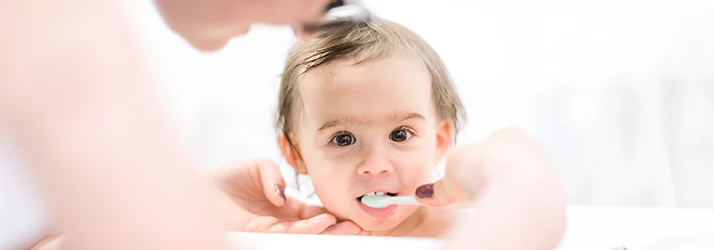How to Brush Your Baby’s Teeth: A Simple Guide for Parents

You may not think about dental care until your child has a full set of teeth—but oral hygiene in CITY1* STATE1* and CITY2* STATE2*starts much earlier. At CLINIC NAME*, we’re here to help you build great habits right from the beginning. Brushing your baby’s teeth is more than just a bedtime routine—it’s a way to protect their health, boost their confidence, and set the tone for a lifetime of strong, cavity-free smiles.
Why Baby Teeth Deserve Big Attention
Even though baby teeth are temporary, they play a huge role in your child’s development. Here’s why taking care of them matters:
- They help your child chew properly and digest food.
- They’re critical for speech development.
- They hold the space for permanent teeth to come in correctly.
- A healthy smile boosts self-esteem, even in toddlers.
Letting decay take hold in baby teeth can lead to pain, infections, and future dental complications—so early care makes a big difference.
When to Start Brushing Baby Teeth
Oral care begins before the first tooth pops through. Here’s a simple timeline to follow:
- Before teeth erupt: Use a soft, damp cloth or gauze pad to gently wipe your baby’s gums after feedings.
- When the first tooth appears: Switch to a baby-sized toothbrush with soft bristles. Add a rice-grain-sized smear of fluoride toothpaste.
- By age 3: Increase to a pea-sized amount of toothpaste and begin encouraging your child to spit, not swallow.
Step-by-Step: How to Brush Your Baby’s Teeth
Let’s make brushing easy and stress-free—for both of you.
1. Pick the Right Tools
- A soft-bristled toothbrush designed for infants
- Fluoride toothpaste (age-appropriate amount)
- A comfy place to sit, like your lap or their high chair
2. Get Into a Good Position
Gently tilt your baby’s head back in a well-lit room so you can see their mouth clearly. Some parents find it easiest to brush when the baby is lying down or reclined.
3. Brush with Gentle, Circular Motions
- Clean the front, back, and chewing surfaces of every tooth
- Brush along the gumline to remove plaque
- Don’t forget those back molars—they’re cavity-prone
4. Keep the Experience Positive
- Sing a song, tell a silly story, or make brushing a game
- Let your baby hold the toothbrush or mimic your movements
- Celebrate cooperation with smiles, claps, or high-fives
5. Wipe or Spit
For babies too young to spit, gently wipe away excess toothpaste with a clean cloth. Older toddlers can learn to spit without rinsing, so the fluoride stays on the teeth longer.
Answering Common Questions Parents
What if my baby hates brushing?
Stay consistent. It may take time, but brushing will become part of the routine. Try brushing in front of a mirror or letting them watch you brush.Is fluoride toothpaste safe for babies?
Yes—just use a small amount. Fluoride helps protect against early decay and strengthens enamel as your child’s teeth grow in.How often should I brush my baby’s teeth?
Twice a day—once in the morning and again before bedtime. Consistency is key!
When Should My Baby See the Dentist?
The American Academy of Pediatric Dentistry recommends scheduling your child’s first dental visit by their first birthday—or within six months of the first tooth erupting. This early appointment helps us check for normal development, answer your questions, and set up a personalized plan for your child’s oral care.
Create a Lifetime of Healthy Habits
Brushing your baby’s teeth is more than a daily task—it’s an investment in their long-term health and happiness. At CLINIC NAME*, we’re proud to support parents every step of the way with expert care, gentle guidance, and a commitment to building strong smiles from the very beginning.
Ready to start your child’s dental journey? Call us today to schedule their first visit—we’re excited to welcome you both!
CLINIC NAME*
ADDRESS*
CITY*, STATE* ZIP*
OFFICE HOURS
Monday
8:30am - 5:00pm
Tuesday
8:30am - 5:00pm
Wednesday
8:30am - 5:00pm
Thursday
8:30am - 5:00pm
Friday
8:30am - 5:00pm
Saturday
8:30am - 2:00pm
Sunday
Closed

